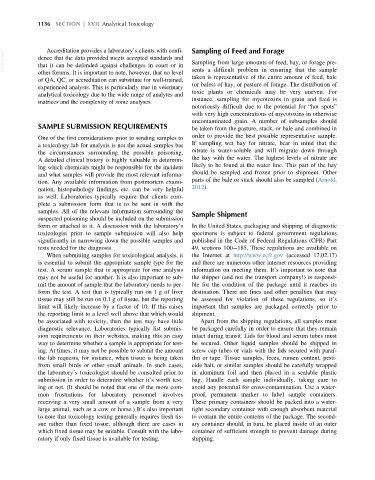Page 1205 - Veterinary Toxicology, Basic and Clinical Principles, 3rd Edition
P. 1205
1136 SECTION | XVII Analytical Toxicology
VetBooks.ir dence that the data provided meets accepted standards and Sampling of Feed and Forage
Accreditation provides a laboratory’s clients with confi-
Sampling from large amounts of feed, hay, or forage pre-
that it can be defended against challenges in court or in
other forums. It is important to note, however, that no level sents a difficult problem in ensuring that the sample
taken is representative of the entire amount of feed, bale
of QA, QC, or accreditation can substitute for well-trained,
(or bales) of hay, or pasture of forage. The distribution of
experienced analysts. This is particularly true in veterinary
toxic plants or chemicals may be very uneven. For
analytical toxicology due to the wide range of analytes and
instance, sampling for mycotoxins in grain and feed is
matrices and the complexity of some analyses.
notoriously difficult due to the potential for “hot spots”
with very high concentrations of mycotoxins in otherwise
uncontaminated grain. A number of subsamples should
SAMPLE SUBMISSION REQUIREMENTS be taken from the pasture, stack, or bale and combined in
One of the first considerations prior to sending samples to order to provide the best possible representative sample.
a toxicology lab for analysis is not the actual samples but If sampling wet hay for nitrate, bear in mind that the
the circumstances surrounding the possible poisoning. nitrate is water-soluble and will migrate down through
A detailed clinical history is highly valuable in determin- the hay with the water. The highest levels of nitrate are
ing which chemicals might be responsible for the incident likely to be found at the water line. This part of the hay
and what samples will provide the most relevant informa- should be sampled and frozen prior to shipment. Other
tion. Any available information from postmortem exami- parts of the bale or stack should also be sampled (Arnold,
2012).
nation, histopathology findings, etc. can be very helpful
as well. Laboratories typically require that clients com-
plete a submission form that is to be sent in with the
samples. All of the relevant information surrounding the Sample Shipment
suspected poisoning should be included on the submission
form or attached to it. A discussion with the laboratory’s In the United States, packaging and shipping of diagnostic
toxicologist prior to sample submission will also help specimens is subject to federal government regulations
significantly in narrowing down the possible samples and published in the Code of Federal Regulations (CFR) Part
tests needed for the diagnosis. 49, sections 100 185. These regulations are available on
When submitting samples for toxicological analysis, it the Internet at http://www.ecfr.gov (accessed 17.02.17)
is essential to submit the appropriate sample type for the and there are numerous other internet resources providing
test. A serum sample that is appropriate for one analysis information on meeting them. It’s important to note that
may not be useful for another. It is also important to sub- the shipper (and not the transport company!) is responsi-
mit the amount of sample that the laboratory needs to per- ble for the condition of the package until it reaches its
form the test. A test that is typically run on 1 g of liver destination. There are fines and other penalties that may
tissue may still be run on 0.1 g of tissue, but the reporting be assessed for violation of these regulations, so it’s
limit will likely increase by a factor of 10. If this raises important that samples are packaged correctly prior to
the reporting limit to a level well above that which would shipment.
be associated with toxicity, then the test may have little Apart from the shipping regulations, all samples must
diagnostic relevance. Laboratories typically list submis- be packaged carefully in order to ensure that they remain
sion requirements on their websites, making this an easy intact during transit. Lids for blood and serum tubes must
way to determine whether a sample is appropriate for test- be secured. Other liquid samples should be shipped in
ing. At times, it may not be possible to submit the amount screw cap tubes or vials with the lids secured with paraf-
the lab requests, for instance, when tissue is being taken ilm or tape. Tissue samples, feces, rumen content, pesti-
from small birds or other small animals. In such cases, cide bait, or similar samples should be carefully wrapped
the laboratory’s toxicologist should be consulted prior to in aluminum foil and then placed in a sealable plastic
submission in order to determine whether it’s worth test- bag. Handle each sample individually, taking care to
ing or not. (It should be noted that one of the more com- avoid any potential for cross-contamination. Use a water-
mon frustrations for laboratory personnel involves proof, permanent marker to label sample containers.
receiving a very small amount of a sample from a very These primary containers should be packed into a water-
large animal, such as a cow or horse.) It’s also important tight secondary container with enough absorbent material
to note that toxicology testing generally requires fresh tis- to contain the entire contents of the package. The second-
sue rather than fixed tissue, although there are cases in ary container should, in turn, be placed inside of an outer
which fixed tissue may be suitable. Consult with the labo- container of sufficient strength to prevent damage during
ratory if only fixed tissue is available for testing. shipping.

